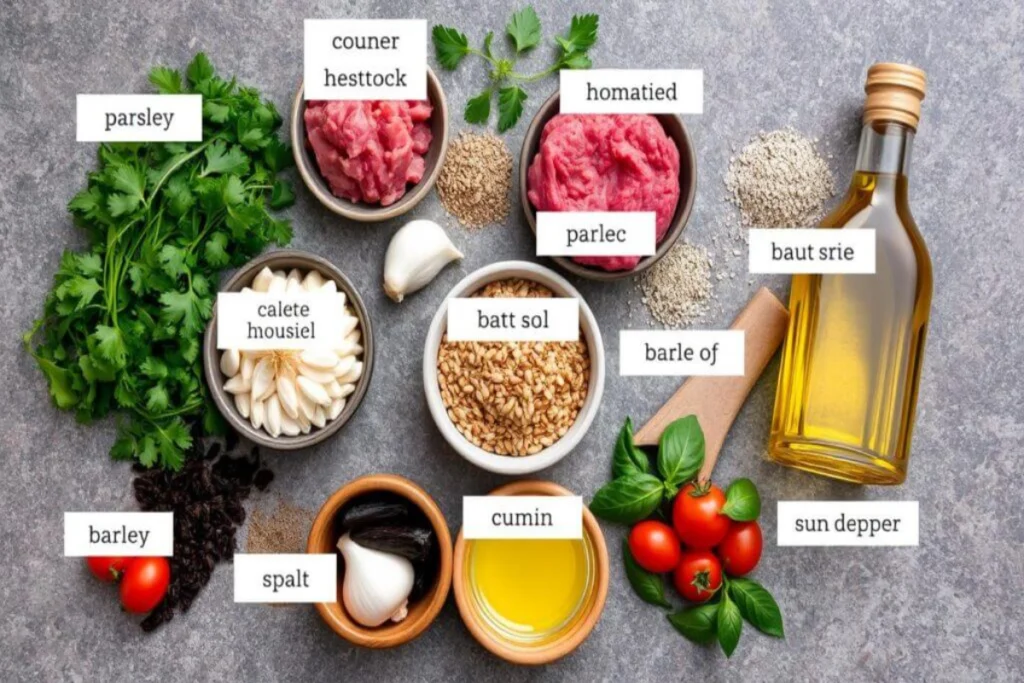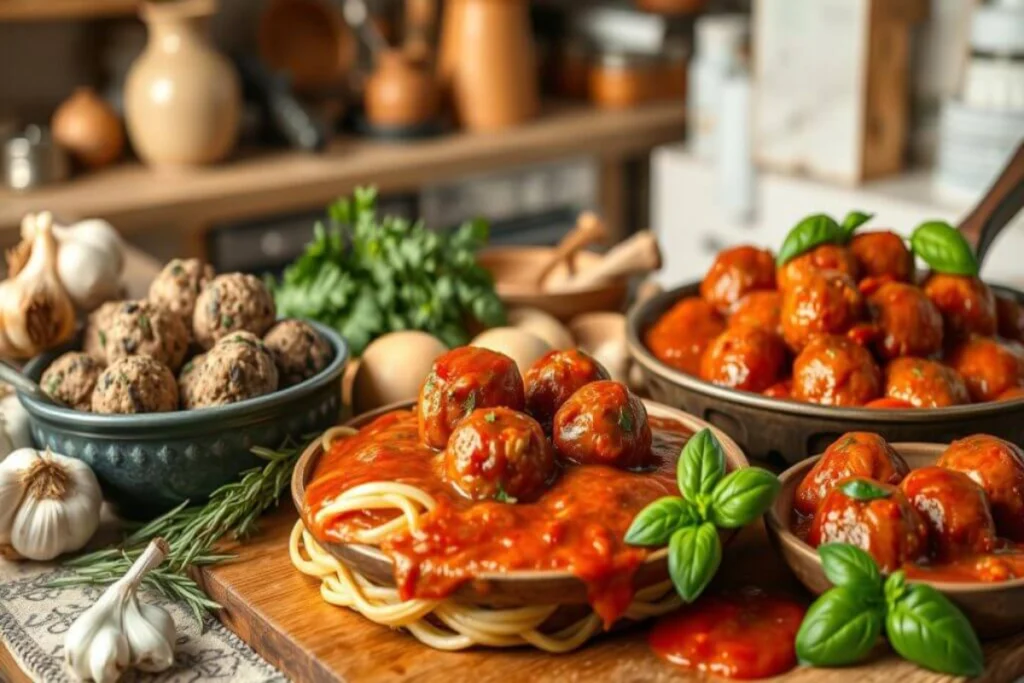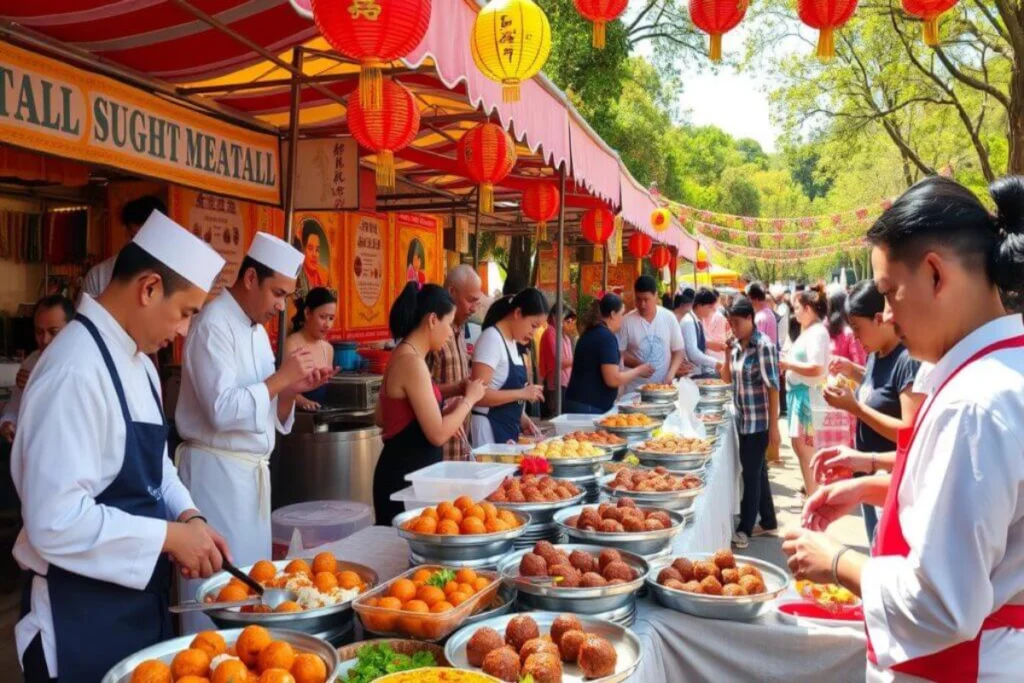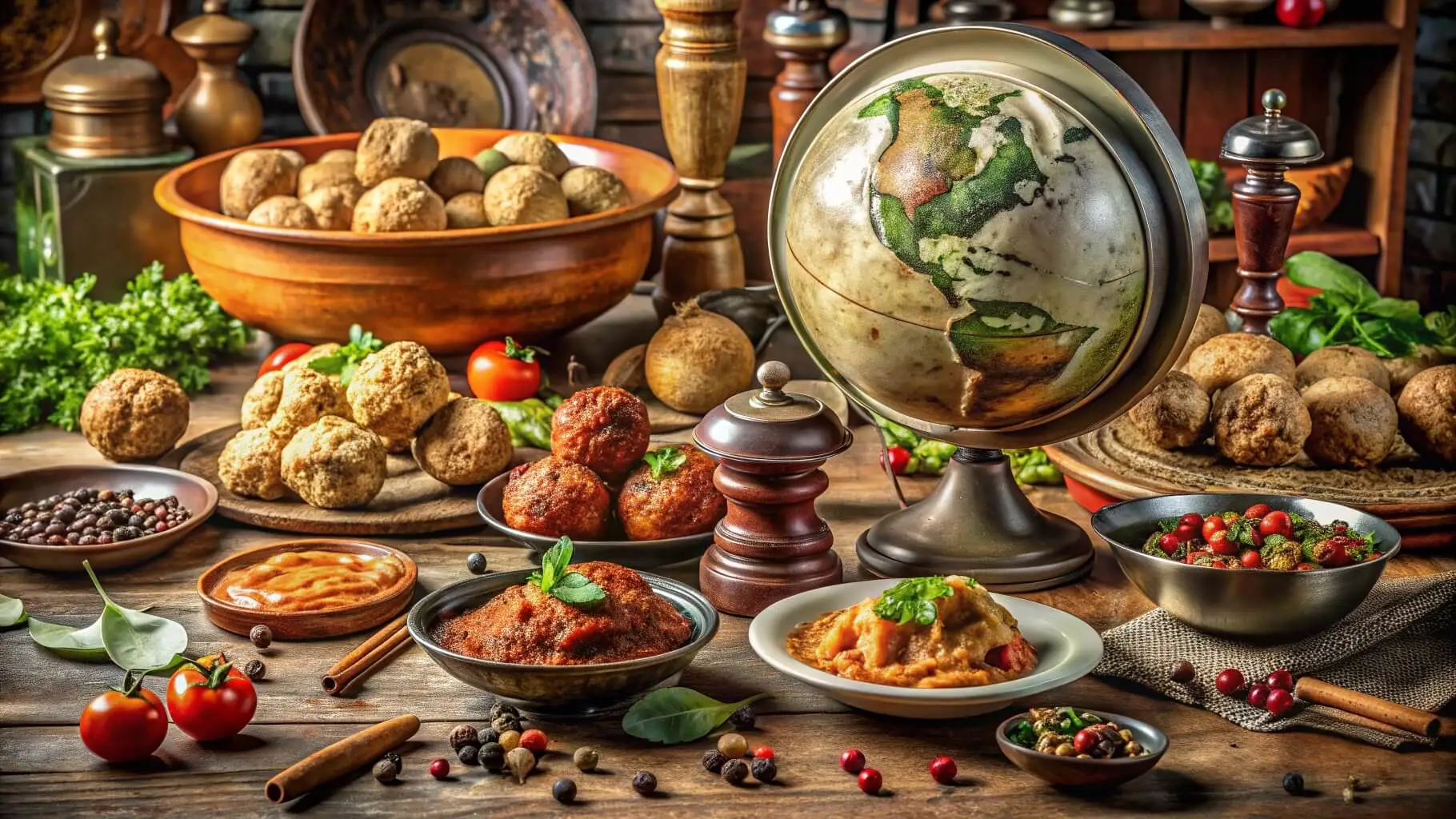Ever notion about the meatball’s mysterious beyond? It’s extra than only a tasty dish. Its history goes again thousands of years, long earlier than your grandma’s kitchen.
The historic meatball is a peek into our culinary past. Archaeologists have observed clues approximately how our ancestors cooked and enjoyed meatballs. It’s a charming take a look at our evolution within the kitchen.
Meatballs were cherished worldwide for a long time. They show up in historical Roman cookbooks and Arabic texts. These small, meaty treats tell tales of creativity, model, and innovation throughout the globe.
Exploring the oldest meatball’s statistics will amaze you. You’ll have a look at ancient cooking traditions that connect us to our past. It’s awesome how a simple dish can screen a lot about our statistics and culture.
The History of Meatballs: A Culinary Overview
The story of meatballs spans millennia, evolving from a simple method of preparing meat into a beloved dish enjoyed worldwide. In ancient times, people created meatballs not just for taste but for food preservation. This innovation gave rise to countless variations across different cultures.
To learn more about other ancient culinary traditions and how early recipes adapted to new circumstances, check out Who Invented Eating Breakfast? for a dive into early morning meal customs.
Origins of Meatballs in Ancient Cultures
Ancient civilizations each had their own way of making meatballs:
- Roman Meatballs: Recipes from the ancient Roman cookbook Apicius featured meatballs made with lamb, rolled in herbs, and glazed with egg yolk.
- Arabic Meatballs: In early Arabic cuisine, meatballs were often made with a mixture of lamb and beef, seasoned with saffron and other spices.
For more about cooking over open flames and ancient cooking methods, you might enjoy reading Can You Cook Brats Over a Campfire on a Stick? to see how ancient and modern techniques intersect.
Meatballs in European Cuisine
In Europe, meatballs were made in many different ways. Each region had its own special style.
| Country | Meatball Variation | Unique Characteristics |
|---|---|---|
| Spain | Albondigas | Typically served in tomato sauce |
| Sweden | Köttbullar | Served with lingonberry sauce |
| Netherlands | Bitterballen | Deep-fried meat ragout balls |
Evolution of Meatballs Over Time
Meatballs have modified through the years, reflecting social and economic shifts. Immigrants added their private meatball traditions to new lands. Italian immigrants, as an instance, tailor-made their recipes to American tastes
Meatballs represent more than just food – they are a delicious narrative of cultural adaptation and creativity.
Today, meatballs are enjoyed worldwide, with each culture adding its own twist. They continue to be a global culinary favorite.
The Oldest Known Meatball: A Unique Discovery
Culinary archaeology has made a groundbreaking find. It shows how ancient people preserved food. This discovery gives us a new look at early diets.
This find is a big step in learning about ancient cooking. Archaeologists have studied it closely. They found out a lot about early food traditions.
Location of the Discovery
The site where the meatball was found is key. It shows how prehistoric people cooked. Researchers used special methods to find it.
- Precise geographical coordinates identified
- Archaeological context carefully documented
- Cultural significance of the site examined
Date of the Discovery
Scientists used special methods to date the meatball. Radiocarbon analysis helped figure out when it was made.
| Dating Method | Estimated Age | Significance |
|---|---|---|
| Radiocarbon Dating | Thousands of Years Old | Confirms Ancient Origin |
| Contextual Analysis | Prehistoric Period | Validates Cooking Techniques |
Historical Significance
This find is a big deal for understanding ancient food ways. It shows our ancestors were skilled cooks. It changes what we thought about their food habits.
“Every meatball tells a story of human innovation and survival” – Archaeological Research Journal
The discovery offers a unique glimpse into early food traditions. If you’re interested in learning about how ancient flavors influence modern dishes, don’t miss Galena Chicken Recipe: The Secret Recipe You’ll Want to Try Tonight for an updated take on traditional flavors.
Ingredients of the Oldest Meatball
Looking into ancient meatballs shows us how people cooked and used ingredients long ago. These early dishes were made with creative methods that highlight human ingenuity in the kitchen.

Meat Choices in Ancient Cuisine
Early cooks picked their meat based on what was available and their culture. Archaeologists have found many types of meat used in ancient dishes:
- Wild game meats
- Domesticated animal proteins
- Chicken and fish variations
- Regional livestock options
Historical Spices and Seasonings
Old chefs made amazing flavors with just a few strong spices. They used local herbs and natural seasonings to make meat taste better.
*”Spices were more than flavor—they were a form of culinary art in ancient cultures.”*
Prehistoric Cooking Techniques
There were many ways to cook early meatballs, showing great creativity. Some methods included:
- Open fire roasting
- Stone pit cooking
- Traditional clay oven preparations
- Slow simmering methods
These old cooking ways helped start the many meatball traditions we love today. They turned simple ingredients into tasty dishes that people all over the world enjoy.
Cultural Variations of Meatballs Globally
Exploring meatballs from around the arena is a journey thru global delicacies. Each culture has its personal way of creating these tasty meat dishes. This indicates the rich food traditions that span continents and generations.
Meatballs are more than only a dish. They open a window into the cooking strategies and flavors of various locations.
Italian Meatballs: Tradition and Variations
Italian meatballs, or polpette, are different from American ones. They are smaller and often served alone or in soups. This shows the detailed approach of Italian cooking.
- Typically made with ground beef or veal
- Smaller in size compared to American versions
- Frequently served as a main course or in soups
Swedish Meatballs: A National Dish
Swedish köttbullar are a symbol of national pride. They mix ground beef and cured meats, creating a unique taste. This flavor has become famous worldwide.
| Ingredient | Characteristic |
|---|---|
| Meat Composition | Mixture of beef and cured meats |
| Serving Style | With lingonberry jam and mashed potatoes |
Middle Eastern Kofta: Meatballs with a Twist
Kofta comes from Persia and is a complex culinary tradition. The word “kūfta” means to beat or grind, showing how it’s made.
“Kofta is not just a dish, it’s a culinary narrative passed through generations” – Anonymous Food Historian
- Found in at least 10 countries
- Turkey produces over 200 unique kofta varieties
- Uses diverse proteins including beef, lamb, and fish
Exploring meatballs from around the world shows how a simple dish can connect people. It highlights the complex cultural traditions behind food.
How Did Meatballs Become a Staple?
The tale of meatballs becoming a staple in America is each captivating and complicated. Between 1880 and 1920, approximately 4 million Italian immigrants got here to the USA. They added with them their wealthy culinary traditions, which greatly inspired American food.
Economic elements have been key within the meatball’s upward push. In Italy, households spent about 75% in their profits on meals. But in America, food fees dropped to simply 25% of their earnings. This exchange allowed for brand spanking new culinary innovations.
Accessibility and Versatility
Meatballs became a hit because they were adaptable to many tastes. Their benefits included:
- Affordable protein source
- Easy to prepare in large quantities
- Adaptable to different meat types
- Suitable for various cooking methods
Influence of Immigration on Meatballs
Italian immigrants changed meatball recipes in America. In Italy, polpette were smaller with equal bread and meat. But in America, meatballs grew larger and meatier, thanks to more meat availability.
“The meatball represents more than just food—it’s a delicious narrative of cultural adaptation and survival.”
Cities like New York and Philadelphia were at the heart of meatball innovation. What began as a simple immigrant dish became a cherished American tradition. It shows how cultural exchange shapes food history.
Famous Meatball Recipes Throughout History
Meatballs have been a hit in the kitchen for centuries. They’ve gone from simple food to fancy dishes. Their journey shows us how recipes and cooking have changed over time.

Notable Recipes from the 19th Century
In the 19th century, cookbooks started sharing detailed meatball recipes. Pellegrino Artusi’s 1881 book “La scienza in cucina e l’Arte di mangiar bene” gave us a peek into Italian meatball making.
- Traditional polpette needed 400 grams of ground beef or veal
- Recipes called for 40 grams of Parmesan cheese and breadcrumbs
- One egg was used to hold everything together
“Meatballs were once a way to use up leftover meat. Now, they’re a key dish in many cuisines.”
Contemporary Twists on Classic Recipes
Today, chefs are putting their own spin on meatballs. They’re using new ingredients and cooking methods. This has made meatballs even more exciting.
- Fusion-style meatballs with Asian spices
- Vegetarian and plant-based options
- Gourmet meatballs made with top-quality meats
From old-school Italian polpette to new global twists, meatballs keep getting better. They show that timeless recipes are always in style.
The Meatball in Popular Culture and Media
Meatballs have become more than just food—they’re a big part of our culture. They’ve appeared in movies and become a hit on social media. These tasty balls have won the hearts of food fans everywhere.
Representation in Literature and Film
Meatballs have made their mark in stories. In movies, they add laughs and warmth to scenes. Films like “Cloudy with a Chance of Meatballs” show their fun side in animation.
Meatballs in Social Media Trends
The internet has changed how we see food. Meatballs are now stars on social media, thanks to:
- Creative meatball recipe challenges
- Multicultural meatball fusion experiments
- Instagram-worthy meatball presentations
“Meatballs aren’t just food—they’re a cultural phenomenon that connects people across generations and cuisines.” – Anonymous Foodie
The world’s biggest meatball, in South Carolina, weighs 1,757 pounds. It took a year to plan and a week to cook. This shows the effort behind viral food trends.
| Meatball Culture Trend | Social Media Impact |
|---|---|
| Recipe Challenges | Millions of views on TikTok and Instagram |
| Cultural Fusion Recipes | Increased global food appreciation |
| Cooking Competition Videos | Growing online culinary community |
Meatballs keep making their way into our culture. They’re in old movies and new social media trends.
Nutritional Value of Meatballs
Meatballs are more than just tasty. They are packed with nutrients that are great for a balanced diet. Knowing about meatball nutrition helps you choose wisely.
Looking for healthy food options? Meatballs are a great choice. They are full of protein, which is good for muscles and health.
Protein Power in Every Bite
Meatballs have 20-25% protein, depending on the meat. Different meats offer different nutrients:
- Beef meatballs: High in iron and zinc
- Chicken meatballs: Leaner protein option
- Mixed meat meatballs: Balanced nutrient profile
Balancing Traditional Recipes with Modern Dietary Needs
Today, meatballs are getting a healthier makeover. Chefs and home cooks are making them better by:
- Reducing fat content
- Incorporating lean meats
- Adding vegetables to increase nutrition
“Nutrition isn’t about perfection, it’s about balance and making informed choices.” – Nutrition Expert
For those watching calories, a meatball has 80 to 150 calories. Choosing lean meats and controlling portions helps keep your diet healthy.
Celebrating Meatballs in Festivals and Events
Meatballs are more than a tasty dish; they’re a way to celebrate and unite communities. Food festivals and events now feature meatballs, making them a cultural highlight. This trend has grown thanks to culinary tourism, bringing people together from all over.

Food festivals focused on meatballs have become a big deal. They show off the amazing variety of this favorite dish. These events celebrate the creativity and love for local food traditions in communities.
Meatball Festivals Around the World
Cities and regions worldwide host meatball festivals that draw in food lovers. Some top festivals include:
- National Meatball Day celebrations on March 9th
- Swedish meatball festivals honoring traditional recipes
- Italian-American community events featuring classic recipes
- Mediterranean food festivals showing off regional meatball styles
Community Involvement and Local Impact
Local meatball festivals do more than offer tasty food. They boost the economy, keep cultural traditions alive, and unite people. Restaurants, home cooks, and food lovers share their special recipes and methods at these events.
“Meatballs are more than just a dish – they’re a celebration of community and culinary tradition.”
These community events help local businesses, encourage culinary tourism, and create lasting memories. They showcase the wide range of meatball styles from different cultures.
The Future of Meatballs: Trends and Innovations
The world of food is changing fast, and meatballs are no exception. Chefs and scientists are exploring new ways to make this classic dish.
Plant-based meatballs are changing the game. They offer a green and tasty alternative to traditional meat. This shift is good for our planet and our health.
Plant-Based Alternatives Reshaping Meatballs
New plant-based meatballs are amazing. They’re made from things like algae and insects. These options are better for the environment and our bodies.
- Algae-based protein sources offer sustainable nutrition
- Insect protein meatballs provide high-efficiency nutrition
- Lab-grown meat alternatives reduce environmental impact
Global Fusion Flavors Expanding Culinary Boundaries
Chefs are mixing things up with meatballs. They’re using spices and ingredients from around the world. This creates unique and delicious flavors.
- Global spice blends from different cultures
- Unexpected protein sources like aquatic plants
- Nutrient-dense ingredients from local farmers
“The future of food is about creativity, sustainability, and reimagining traditional recipes.” – Food Innovation Expert
Soon, we might be able to make our own meatballs at home. 3D printing could make this possible. It’s an exciting time for food technology.
Interesting Facts About Meatballs
Explore the world of unique meatballs and discover amazing culinary records. These records include massive restaurant challenges and extraordinary preparation techniques. Meatballs have an incredible story to tell.
Record-Breaking Meatballs
Meatball lovers have achieved incredible feats. Here are some amazing food trivia highlights:
- Mama’s on the Hill in St. Louis serves a huge two-pound meatball in 4.5 pounds of spaghetti
- LAVO in Las Vegas offers meatballs that weigh a full pound each
- Carmine’s in New York City makes about 500 palm-sized meatballs every day
The World’s Most Expensive Meatball
Some restaurants make meatballs very special and expensive. Rao’s restaurant, open for over 125 years, is known for its legendary meatballs.
| Restaurant | Unique Meatball Feature | Culinary Record |
|---|---|---|
| IKEA | Introduced chicken and veggie ball options | Expanded meatball variety in 2015 |
| The Meatball Shop | Custom sauce and topping selections | Personalized meatball experience |
| Gorat’s | Meatball preparation challenge | 1,100 meatballs made by 10 participants |
These stories show the creativity and passion for meatballs. Whether it’s a big challenge or a new recipe, meatballs keep our culinary dreams alive.
Meatballs are more than just food—they’re a global culinary adventure waiting to be explored!
Conclusion: The Legacy of Meatballs
Meatballs are more than just a dish. They connect generations and cultures worldwide. Your love for them shows our shared love for food and tradition.
The story of meatballs is one of growth and change. They move from Italian-American to Middle Eastern tables. This shows how simple ingredients can become something amazing. It’s a story of our creativity in cooking.
Why Meatballs Will Always Remain Popular
Meatballs are loved for their flexibility and taste. They fit into many dishes, bringing comfort and warmth. Their lasting appeal shows that some foods are truly timeless.
The Cultural Significance Continuing Forward
Meatballs stand strong against changing food trends. They remind us that food is about memories and family. Your love for them keeps this tradition alive, inspiring others to explore global cuisine.
FAQ
Q: What makes the world’s oldest meatball significant?
A: The world’s oldest meatball is a key find that shows us how our ancestors cooked and ate. It gives us a peek into ancient food ways and what people ate long ago.
Q: Where was the oldest meatball discovered?
A: Researchers found the oldest meatball at a special site. This site tells us a lot about where it came from and the culture of the time.
Q: How do different cultures prepare meatballs?
A: Meatballs vary a lot around the world. You can find Italian polpette, Swedish köttbullar, and Middle Eastern kofta. Each place has its own special way of making meatballs.
Q: What were the original ingredients of ancient meatballs?
A: Ancient meatballs were made with what was available. This could be wild game, domestic animals, or even ground meats mixed with grains or herbs. It all depended on where they were and what they knew about cooking.
Q: Are there vegetarian or plant-based meatball alternatives?
A: Yes, there are many plant-based meatballs now. They use things like lentils, chickpeas, mushrooms, and plant proteins. These options are good for people who don’t eat meat but want to enjoy meatball flavors.
Q: How nutritious are traditional meatballs?
A: Traditional meatballs are full of protein and can be good for you. But, nutritionists say to watch the fat content and think about your diet as a whole.
Q: Are there any famous meatball festivals?
A: Yes, many places have meatball festivals. Italy, Sweden, and cities in the U.S. celebrate with food, cooking contests, and fun. These festivals bring people together through their love of meatballs.
Q: What role did immigration play in meatball cuisine?
A: Immigration helped spread meatball recipes all over. Italian immigrants, for example, brought their meatball recipes to new places. There, they adapted them to local tastes and helped make meatballs popular worldwide.
Q: How have meatballs been represented in popular culture?
A: Meatballs have been in movies, books, and on social media. They’re a fun topic in food culture and often spark viral food challenges.
Q: What is the future of meatball cuisine?
A: Meatballs are getting a modern twist. Expect to see new flavors, plant-based options, and creative takes on traditional recipes. This is all thanks to new tastes and tech.

